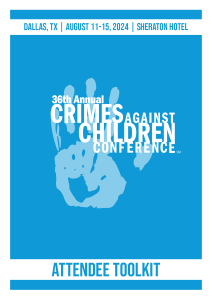Back
Workshop
Sheraton Conference Center - 1st Floor
Child Death/Homicide Investigations (Part 2) REPEAT
Wednesday, August 14, 2024
10:15 AM – 11:30 AM CT
Location: Dallas C
Credit Hours: 1.25
- JH
Jim Holler
Consultant - Police Chief (Retired)
Holler Training
Primary Presenter(s)
This workshop will address the duties of investigating officers and detectives as they begin to investigate a child death and what forms of evidence should be collected in every case. Investigators will be provided with the essential information on the use of consent forms, the neglect of children, the dynamics of physical abuse, and the reconstruction and investigation of soft tissue injuries. The training will also address the duties of the first responding police officer, which in some of the small agencies may be the officer who will ultimately investigate the child’s death. The presenter will address investigative techniques to help determine whether the child’s death was a natural, accidental, suicidal, or homicidal death as well as finding any key crime scene and forensic evidence techniques that could be used by the officer as well as stressing the importance of an initial investigation of the residence or area where the child’s body was located, and what can be done to help assure that the entire crime scene was thoroughly processed.
Learning Objectives:
- Define and recognize certain types of injuries, such as, burns, bites, bruises, head injuries, abdominal injuries, and fractures
- Learning how to distinguish between accidental injuries and intentional injuries found on children after death
- Learning key investigative techniques to use when child abuse and/or neglect is the suspected cause of the death of a child

